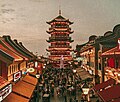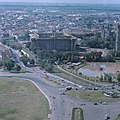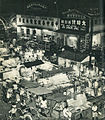Portal:Jakarta
The Jakarta Portal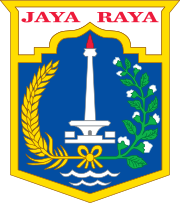 Jakarta (/dʒəˈkɑːrtə/; Indonesian pronunciation: [dʒaˈkarta] , Betawi: Jakartè), officially the Special Capital Region of Jakarta (Indonesian: Daerah Khusus Ibukota Jakarta, abbreviated to DKI Jakarta) and formerly known as Batavia until 1949, is the nation's capital city and the centre of the largest metropolis of Indonesia. Lying on the northwest coast of Java, the world's most populous island, Jakarta is the largest metropole in Southeast Asia, and serves as the diplomatic capital of ASEAN. Jakarta is bordered by two provinces: West Java to the south and east; and (since 2000, when it was separated from West Java) Banten to the west. The Special Capital Region has a status equivalent to that of a province. Its coastline faces the Java Sea to the north, and it shares a maritime border with Lampung to the west. Jakarta's metropolitan area is ASEAN's second largest economy after Singapore. Jakarta is the economic, cultural, and political centre of Indonesia. It possesses a province-level status and has a population of 10,679,951 as of mid-2022. Although Jakarta extends over only 661.23 km2 (255.30 sq mi) and thus has the smallest area of any Indonesian province, its metropolitan area covers 9,957.08 km2 (3,844.45 sq mi), which includes the satellite cities of Bogor, Depok, Tangerang, South Tangerang, and Bekasi, and has an estimated population of 32.6 million , making it the largest urban area in Indonesia and the second-largest in the world (after Tokyo). Jakarta ranks first among the Indonesian provinces in the human development index. Jakarta's business and employment opportunities, along with its ability to offer a potentially higher standard of living compared to other parts of the country, have attracted migrants from across the Indonesian archipelago, making it a melting pot of numerous cultures. Jakarta is one of the oldest continuously inhabited cities in Southeast Asia. Established in the fourth century as Sunda Kelapa, the city became an important trading port for the Sunda Kingdom. At one time, it was the de facto capital of the Dutch East Indies, when it was known as Batavia. Jakarta was officially a city within West Java until 1960 when its official status was changed to a province with special capital region distinction. As a province, its government consists of five administrative cities and one administrative regency. Jakarta is an alpha world city and is the seat of the ASEAN secretariat. Financial institutions such as the Bank of Indonesia, Indonesia Stock Exchange, and corporate headquarters of numerous Indonesian companies and multinational corporations are located in the city. In 2021, the city's GRP PPP was estimated at US$602.946 billion. Jakarta's main challenges include rapid urban growth, ecological breakdown, gridlocked traffic, congestion, and flooding due to subsidence (sea level rise is relative, not absolute). Jakarta is sinking up to 17 cm (6.7 inches) annually, which has made the city more prone to flooding and one of the fastest-sinking capitals in the world. In response to these challenges, in August 2019, President Joko Widodo announced plans to move the capital from Jakarta to the planned city of Nusantara, in the province of East Kalimantan on the island of Borneo. The MPR approved the move on 18 January 2022. (Full article...) Selected article -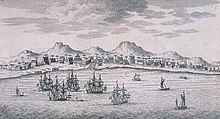 Colonial buildings and structures in Jakarta include those that were constructed during the Dutch colonial period of Indonesia. The period (and the subsequent style) succeeded the earlier period when Jakarta (known then as Jayakarta/Jacatra), governed by the Sultanate of Banten, were completely eradicated and replaced with a walled city of Batavia. The dominant styles of the colonial period can be divided into three periods: the Dutch Golden Age (17th to late 18th century), the transitional style period (late 18th century – 19th century), and Dutch modernism (20th century). Dutch colonial architecture in Jakarta is apparent in buildings such as houses or villas, churches, civic buildings, and offices, mostly concentrated in the administrative city of Central Jakarta and West Jakarta. Below is a list of colonial buildings and structures found in Jakarta. The list is sorted alphabetically according to its official (local) name. The list can also be sorted to each category. (Full article...)Selected image - Lubang Buaya is the site of the murder of seven Indonesian army officers during the 1 October coup attempt of the 30 September Movement. Pictured is the well down which the army officers' bodies were dumped.
In this month
Related portalsSelected biography -
Ismail Marzuki (also known as Bang Ma'ing; 11 May 1914 – 25 May 1958) was an Indonesian composer, songwriter and musician who wrote around 202 to 240 songs between 1931 and 1958, including numerous popular patriotic songs. Among his best-known works are "Halo, Halo Bandung", "Gugur Bunga", and "Rayuan Pulau Kelapa". In 1968, he was honoured with the creation of the well-known Taman Ismail Marzuki (the Ismail Marzuki Park, often called TIM) which is a cultural centre in Menteng in central Jakarta. In 2004 he was declared one of the National Heroes of Indonesia. (Full article...)
General imagesThe following are images from various Jakarta-related articles on Wikipedia.
Did you know (auto-generated)
TopicsCategoriesWikiProjectsWant to help?:
Associated WikimediaThe following Wikimedia Foundation sister projects provide more on this subject:
Discover Wikipedia using portals |







